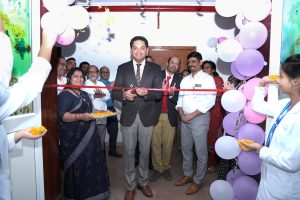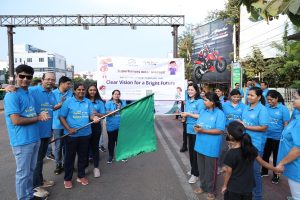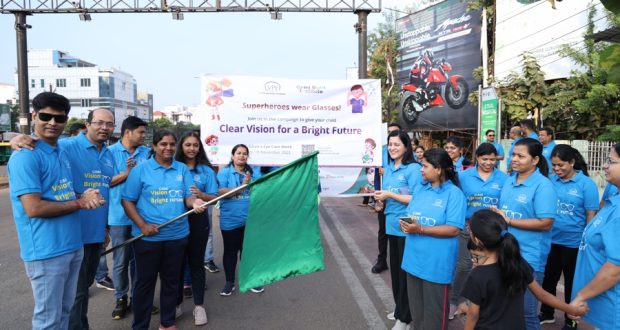TBB BUREAU
BHUBANESWAR, NOV 23, 2023
L V Prasad Eye Institute (LVPEI) concluded its Children’s Eye Care Week with an awareness walk on Sunday, centred around refractive errors in children. This vibrant week-long celebration marked the 15th-year milestone of LVPEI’s dedicated children’s eye care unit, the Miriam Hyman Children’s Eye Care Centre.
 Dr Ramesha Kekunnaya, Director of Child Sight Institute, LVPEI, and Dr Srikant Sahu, Head of LVPEI, Bhubaneswar, inaugurated the newly renovated and updated outpatient wing in this paediatric facility, underscoring the centre’s commitment to providing excellent eye care services and eradicating avoidable blindness in children.
Dr Ramesha Kekunnaya, Director of Child Sight Institute, LVPEI, and Dr Srikant Sahu, Head of LVPEI, Bhubaneswar, inaugurated the newly renovated and updated outpatient wing in this paediatric facility, underscoring the centre’s commitment to providing excellent eye care services and eradicating avoidable blindness in children.
The celebrations featured an array of engaging programs, including a live art exhibition, a children’s painting competition, an enlightening awareness talk, a knowledge-packed expert lecture, and an insightful surgical workshop. These initiatives were carefully curated to share knowledge and amplify awareness about refractive errors in children. In the spirit of inclusivity, a special fun camp was organized for children with special needs and their parents from two blind schools in Bhubaneswar.
Refractive errors, such as myopia (nearsightedness), hypermetropia (farsightedness), and astigmatism, can affect children due to natural differences in eyeball sizes, leading to difficulties in correctly processing images. These errors often result in symptoms like headaches, eyestrain, and fatigue during reading and may even lead to the development of squint as children adapt to visual challenges.
 Uncorrected refractive errors are a significant global concern and a leading cause of blindness. In India, 20% of visually impaired individuals suffer from unaddressed refractive errors. The prevalence of myopia, in particular, is rising, posing a potential public health crisis. Without intervention, projections suggest that nearly half of the world’s population may be affected by myopia by 2050.
Uncorrected refractive errors are a significant global concern and a leading cause of blindness. In India, 20% of visually impaired individuals suffer from unaddressed refractive errors. The prevalence of myopia, in particular, is rising, posing a potential public health crisis. Without intervention, projections suggest that nearly half of the world’s population may be affected by myopia by 2050.
Dr Vivek Warkad, Head of Miriam Hyman Children’s Eye Care Centre at LVPEI Bhubaneswar, emphasized the importance of recognizing early signs of refractive errors, urging immediate consultation with an eye specialist. Addressing the gathering at the Children’s Eye Care Walk, he spoke about the standard early symptoms to see if a child has refractive error, such as reading or watching television at a close distance, difficulty seeing the blackboard clearly at school, frequent headaches, eyestrain, and squeezing or squinting of the eyes. “Early diagnosis and treatment of refractive errors are crucial, with eye examinations recommended at ages one, three, and five,” he added.
The reasons for the surge in refractive errors are complex. Genetics play a role, with a higher likelihood of Myopia if one or both parents have it. Environmental factors, such as prolonged near-work, excessive screen time, and insufficient outdoor activities, predispose one to Myopia. Exposure to dust and smoke can cause eye allergies, and constant eye rubbing can increase the risk of astigmatism. The impact of these conditions on children is profound. Children adapt to their blurred vision, adjusting to close-range activities and avoiding tasks that require sharp focus, affecting their academic performance and taking a toll on their psychological well-being.
Simple solutions like glasses or contact lenses can effectively address refractive errors. Regular follow-ups are essential to monitor changes in prescription, treat lazy eye, and manage progressive refractive errors.
LVPEI advocates preventive measures such as managing screen time, encouraging outdoor time, optimal reading time, and following 20-20-23 rule to reduce the risk of refractive errors and their progression in children.
Dr Debasmita Majhi, Paediatric Ophthalmologist, LVPEI, highlighted the potential consequences of undiagnosed and untreated refractive errors, including delayed milestones, negative impacts on academic performance, participation in activities, and social behaviour. She said children with myopia face a higher risk of developing serious eye diseases, emphasizing the collective responsibility of families, teachers, healthcare professionals, and the government to ensure children’s well-being.
 The Business Bytes
The Business Bytes
